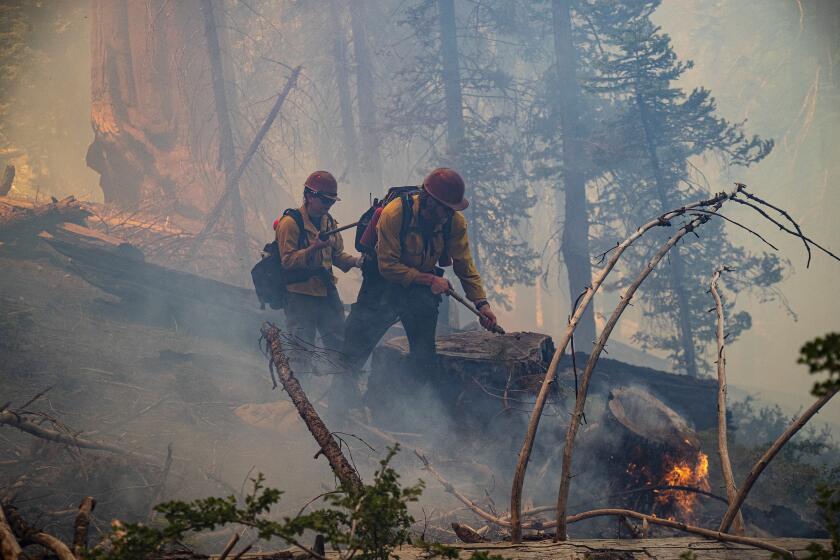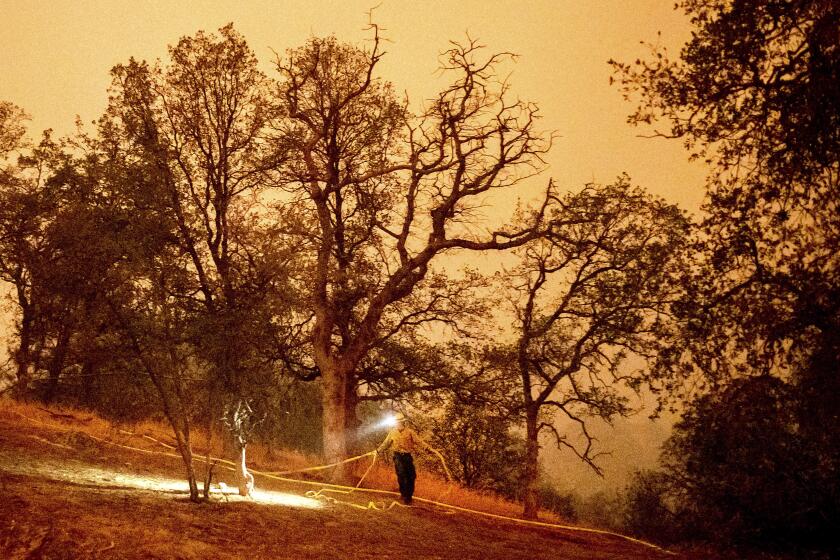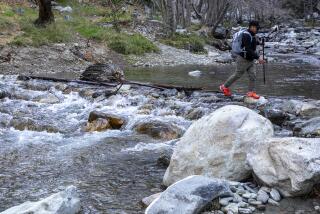Anger builds after controlled burn badly damages California sequoias
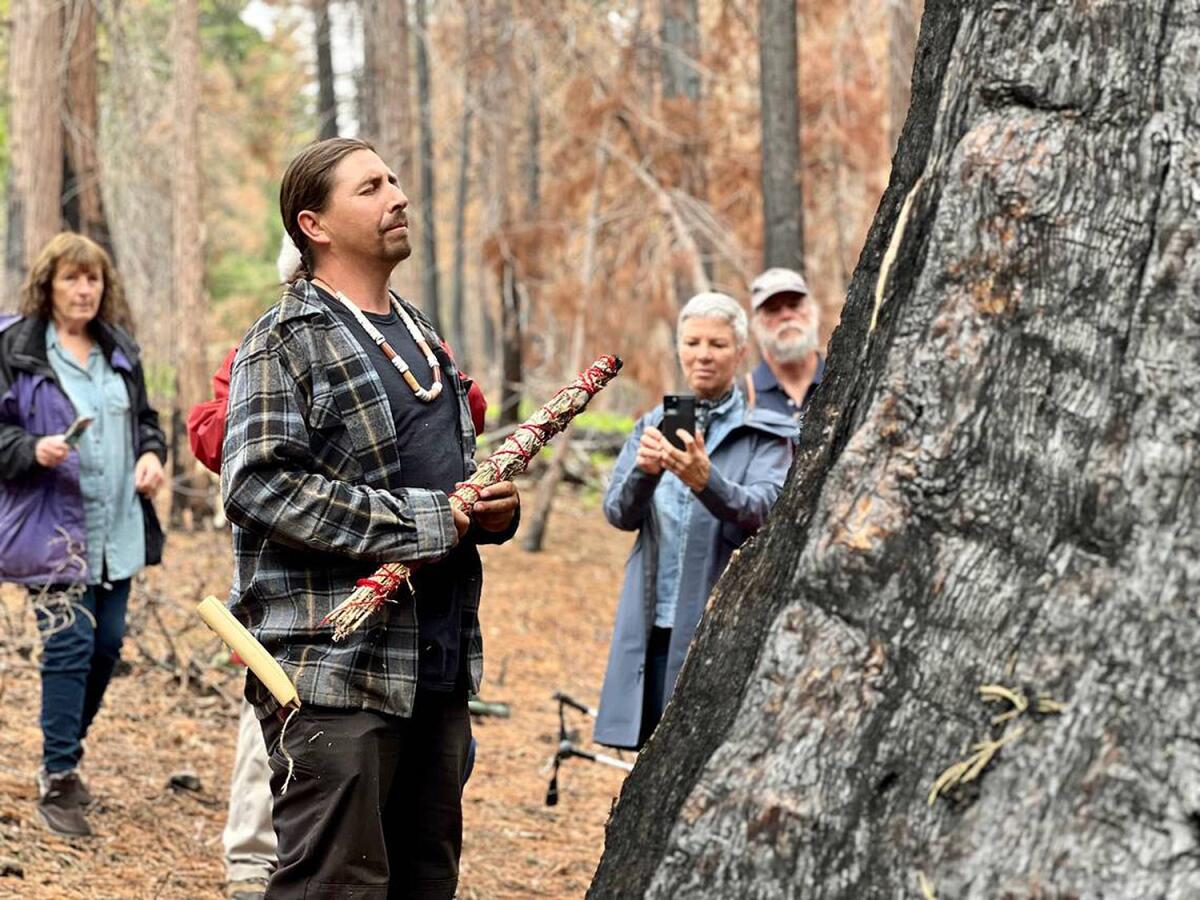
- Share via
They are called “the Orphans” and they have stood side by side in what is now Calaveras Big Trees State Park for more than five centuries.
But today, fans of the giant sequoias fear that one of the towering duo may soon perish after a prescribed fire that was intended to protect them, but instead roasted the trees’ massive trunks and killed most of their canopies.
The burn — and the extensive damage it inflicted on the beloved sequoias — has tapped a deep vein of anger and fear in a Northern California mountain community, where the worry over catastrophic wildfire has grown steadily over the last decade. It has also served to undermine local confidence in how state parks officials perform controlled burns — one of the key tools for reducing the severity of wildfires in an era of extreme drought and climate change.
“The serious damage done to these ancient trees was a wake-up call,” said Arnold resident Marcie Powers.
She and others say they are outraged by the way the burn was conducted, and accuse park officials of failing to adequately prepare the forest before setting it alight. Now, they say they have little faith in the park’s ability to conduct a much larger prescribed burn planned for the fall.
Park officials deny the charges, and say they took all necessary precautions to avoid a mishap when the burn was conducted last fall. They say the trees appear to have been weakened by years of drought, making them more susceptible to heat.
The prescribed fire claims fund can cover losses in the rare event a prescribed or cultural burn escapes and causes damage.
“It is just a reality of the situation where sometimes you do lose a very small percent of the ecosystem you were trying to protect,” said Jay Chamberlain, chief of California State Parks’ Natural Resources Division.

Tucked within the western Sierra Nevada, halfway between Yosemite National Park and Lake Tahoe, Calaveras Big Trees is the only state park where giant sequoias grow. More than 1,000 grow in the remote South Grove, while some 100 populate the North Grove.
Like many California landscapes, the park suffers from an overgrowth of vegetation — a condition that started to take root more than 150 years ago, when Gold Rush settlers began to systematically snuff out naturally sparked blazes and those set by Indigenous people.
As part of an estimated $7-million, five-year plan of prescribed burns, park crews set fires in about 180 acres of the North Grove from Oct. 20 to Nov. 4.
The goal was to reduce dead and downed vegetation, slow the regeneration of Pacific dogwood and expose patches of mineral soil where sequoia seedlings could take root, according to an incident action plan.
Before the burn, crews raked 3-foot lines around the Orphans’ roots to move away leaves and needles. They also cleared heavy vegetation and downed limbs within a 20-foot radius of the trunks, said Danielle Gerhart, superintendent for the Central Valley District. Some snags — standing dead trees — were felled, and logs were removed, she said.

Despite these precautions, the Orphans were badly damaged — although it took months for anyone to realize it.
A winter storm shut down the main road into the park less than a week after the burn. When the snow cleared in mid-April, Joan Perry walked her dog along the road and spotted the Orphans.
“I hadn’t seen them all winter,” said the semi-retired schoolteacher, whose backyard abuts the park. “And I come around the bend and I look at their tops and they’re brown, they’re not green. As I got closer, I could see that their trunks were scorched.”
Crews recently planted 30,000 giant sequoia seedlings in the western Sierra, as part of an ongoing effort to restore groves devastated by wildfire.
When Perry looked at the other mature giant sequoias in the burn area, it appeared flames had reached only 3 to 5 feet up their trunks, she said. But the Orphans were scorched all the way into their crowns, more than 100 feet off the ground, she said.
State park officials aren’t sure exactly what happened. Giant sequoias have not only evolved to withstand low-intensity fires sparked by lightning, they rely on fire to reproduce — their cones open and release seeds only in response to bursts of heat.
The Orphans did not catch fire but were damaged by radiant heat, possibly from sparks igniting a nearby tree or snag, Gerhart said. The trees’ vulnerability may have been exacerbated by a lack of soil moisture because of the drought, worsened by climate change, she said.
A giant sequoia can survive if just 15% to 20% of its crown remains intact, although the loss makes the tree more vulnerable to diseases and future fires. One of the Orphans appears likely to survive. The other has fewer green needles left and may die. If that happens, it will be left in place to serve as wildlife habitat.
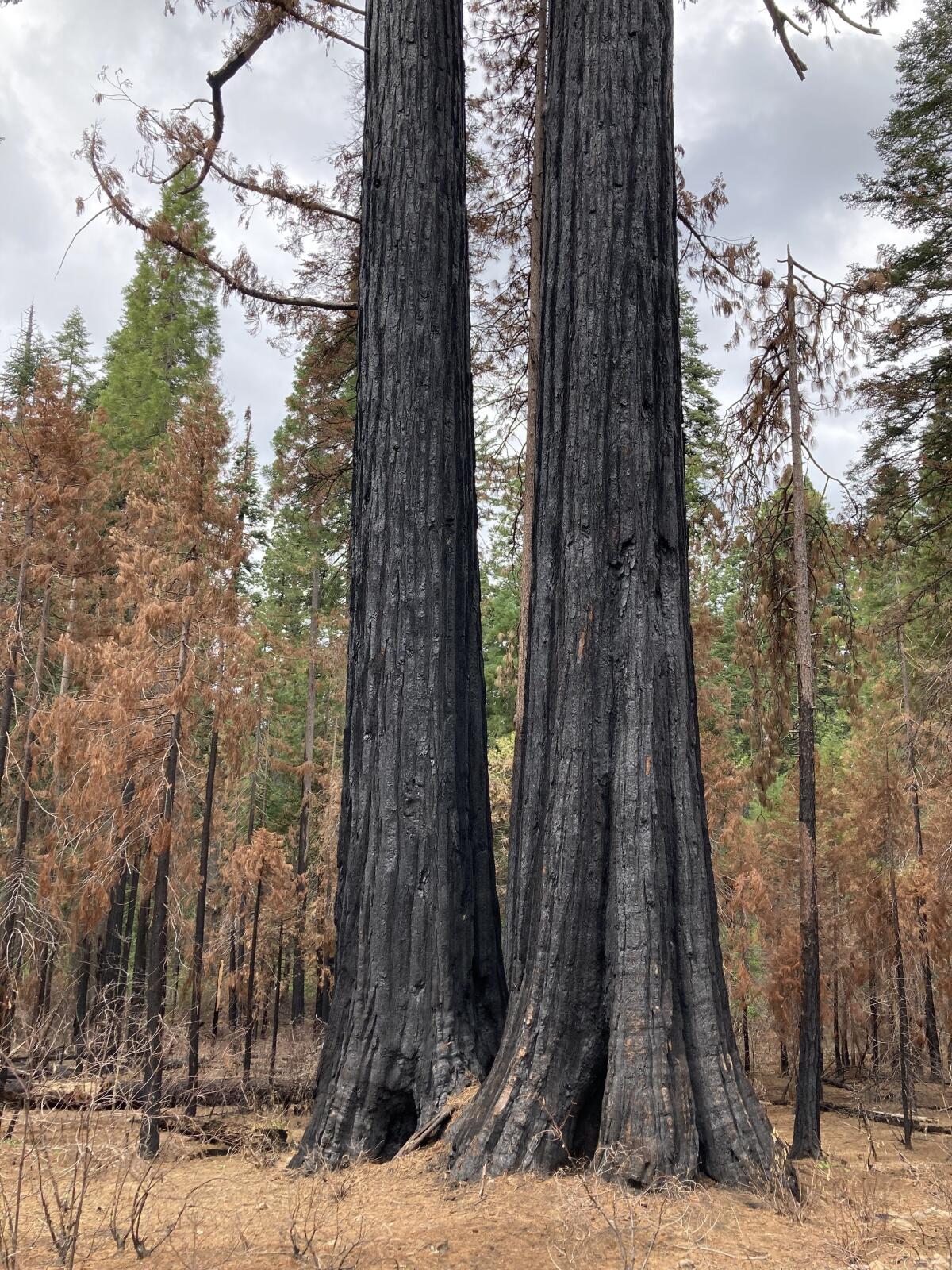
Word of the damage spread.
Tom Van Lokeren, Powers’ husband, organized a gathering in which residents prayed for the trees, which were named the Orphans because they were set apart from other sequoias in the grove.
“It really pulls at your heartstrings that these two trees, out away from the rest of the family, were forgotten,” said the retired forensic accountant.
Along with news of the damage, rumors began to spread of state negligence: Some claimed officials failed to perform forest thinning that could have spared the Orphans. Others claimed crews stood idly by as flames climbed the trees and raged through their canopies.
“It’s really created a lot of tension in our community,” Van Lokeren said.
The controversy comes at a time when state officials and others have been attempting to encourage broader use of “good fire” as a means of removing dense trees and brush that could fuel a damaging wildfire. Recently, the state rolled out a $20-million claims fund to cover damages should a controlled burn escape.
Some experts worry the outcry over the Orphans will jeopardize efforts to safeguard other ancient groves.
They say that high-severity wildfire poses an existential risk to giant sequoias, which grow nowhere else in the world. Already, three fires in the southern Sierra are estimated to have killed nearly 20% of the population in just two years.
“If we’re going to say that if we can’t perfectly prep every single giant sequoia then we can’t burn, we’re taking a big gamble there,” said Kristen Shive, a fire ecologist and assistant professor at UC Berkeley. “It’s impossible to say you would never lose one in a prescribed burn, but you are going to lose far fewer in the long run.”
Park officials maintain that the fire that damaged the Orphans was a good burn overall — not only did it clear away vegetation that could carry high-severity fire, but baby sequoias have sprouted up in the mineral soil beneath the scorched giants.
The 8,940-acre KNP Complex fire is within striking distance of Sequoia National Park’s Giant Forest, home to the largest tree on Earth, officials said.
Amid the backlash, some residents worry the park’s overgrown condition could stoke a fast-moving wildfire and endanger communities dotting the fire-prone corridor along Highway 4 — the area’s only escape route.
“If you ask anybody up here, it’s not a question of if, it’s a question of when,” said David Vassar, a filmmaker who lives less than two miles from the park.
When she sits on her side deck, Perry said she can see “easily 300 dead trees” in the park. She estimates that at least half a dozen have fallen onto her property since 2018, after a die-off caused by drought and bark beetles.
While the California Department of Forestry and Fire Protection requires nearby homeowners to keep their yards clear of needles and fallen trees, the park isn’t held to the same standards, Perry said.
“By protecting the forest within the park boundaries, they also protect the lives and the livelihoods of their Arnold neighbors,” she said. “And I’m not sure how much that has been taken into consideration with the park’s planning.”
The park has failed to maintain its land for years, said Pat McGreevy of the Calaveras Amador Forestry Team, a group of retired foresters and resource specialists who banded together after the 2015 Butte fire, which destroyed hundreds of homes.
The group has secured nearly $5.6 million in grant funding to build 3,500 acres of shaded fuel breaks from the village of Murphys to the border of the park, mostly along the rim of the North Fork Stanislaus Canyon, he said. Within the project footprint, crews thinned big trees to prevent fire from leaping from treetop to treetop, and masticated — or ground up — smaller trees and surface vegetation to keep flames closer to the ground.
The goal is to give firefighters an opportunity to fight blazes that start deep in the canyon and race up the wall, McGreevy said.
But there’s a hole in the network, McGreevy said: Calaveras Big Trees officials declined the group’s offer to extend the fuel break through the park with 270 acres of mastication, even though the organization said it would secure grant funding and ensure quality control.
“It’s the Achilles’ heel of the defense system that we’re trying to construct,” he said.

Now, as park officials go forward with plans for a 1,300-acre prescribed burn in the South Grove this fall, residents are anxious.
They point out that the grove has experienced virtually no significant recent fire, leading some experts to declare it the most at risk of catastrophic wildfire among all the unburned sequoia groves in California. There are also thousands of piles of trimmed vegetation awaiting disposal.
“When you look at the South Grove, it is so choked that it’s frightening to think about burning it,” Powers said.
Until recently, the retired press secretary had served on the board of the Calaveras Big Trees Assn., a nonprofit that raises funds for the park’s educational and interpretive programs. In February of last year, the board passed a resolution urging the park to thin more trees and vegetation before the next prescribed burn, she said.
Members of the Southern Sierra Miwuk Nation became the latest Indigenous tribe to watch homes burn despite knowing it could have been avoided.
“We envisioned bringing in the same firefighter infrastructure that you bring in when you have a fire — put up the tents in the campground, put up the portable showers and food stations, the medical tents,” she said.
Unsatisfied with the park’s response — and heartbroken by the damage to the Orphans — Powers recently resigned from the board to found Save Calaveras Big Trees with her husband. Its goal is to get the park to do more thinning, mastication and biomass removal in addition to prescribed burns, she said. If that isn’t possible, she’d like to see the federal government step in and take over management, she said.
Park officials say they are committed to the task.
The South Grove burn was initially scheduled for spring in 2022, but conditions were too dry and the unit wasn’t ready, so Cal Fire, in conjunction with park officials, called it off, Gerhart said.
In preparation for the fall burn, Gerhart said, workers have already begun clearing dead and downed material from around the trunks of monarch sequoias — the largest trees in the grove. They’ve also hired a contractor to help remove large logs from around the burn perimeter and about 50 feet into the preserve, and they’re masticating trees and brush along the boundary edge, as well as some of the piles, she said.
“We all want to get this work done, and we all wish it could go faster,” Gerhart said, “but we’re working really hard to get it completed.”
More to Read
Sign up for Essential California
The most important California stories and recommendations in your inbox every morning.
You may occasionally receive promotional content from the Los Angeles Times.

